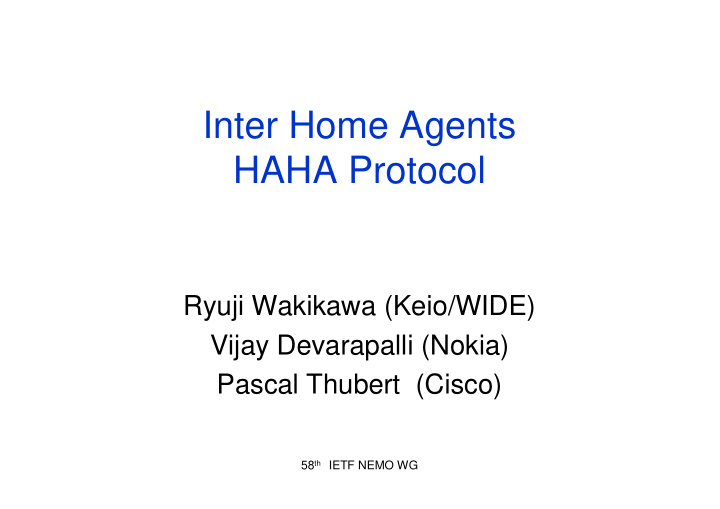



Inter Home Agents HAHA Protocol Ryuji Wakikawa (Keio/WIDE) Vijay Devarapalli (Nokia) Pascal Thubert (Cisco) 58 th IETF NEMO WG
Problem Statement • NEMO inconsistency – L2 centric by MIP6 inheritance – L3 centric to manage MNP routes • Redundancy – HA is single point of failure of NEMO basic support – Another HA should be able to take over 58 th IETF NEMO WG
Problem Statement cont. • Load balancing – HA becomes considerable bottleneck of communication in terms of high load caused by tunneling • HA preference – If a mobile router moves over a wide area, it is better to use a closer home agent • ex. Airplane flight from Japan to USA – Correspondent Nodes can use the nearest Home Agent 58 th IETF NEMO WG
HA Distribution • Configure multiple home agents regardless of topological position – Local distribution for high availability – Remote distribution for some degree of multihoming and route optimization • Each home agents advertises distributed home network prefix • A binding and mobile network prefix for a particular mobile router is synchronized among all home agents MR HA HA Internet Internet HA HA HA HA 58 th IETF NEMO WG
Multiple Home Agent Support • activate multiple home agents simultaneously in terms of binding synchronization • reduce hoplimit of redundant route path in terms of multiple home agents activation HAs MR MR HA CN1 CN2 CN1 HA 58 th IETF NEMO WG
HA Selection • MR can associate with the best available home agent depending on its location, HA load, preference, etc • Two schemes – MR initiated switching • MR detects the high round trip time or considerable delay, it can request to switch its primary HA – HA initiated switching • If HA detects its overload or trouble (need reboot), it can ask MR to change their primary home agent to new one • If HA detects there is better HA rather than it for MR, it can force MR to switch primary HA to the better HA 58 th IETF NEMO WG
End • Question?? 58 th IETF NEMO WG
Recommend
More recommend